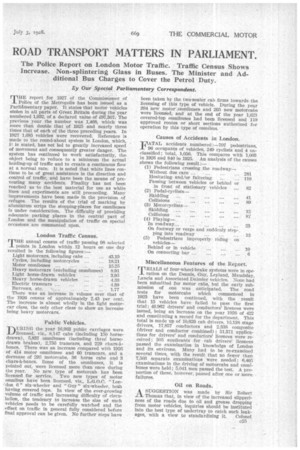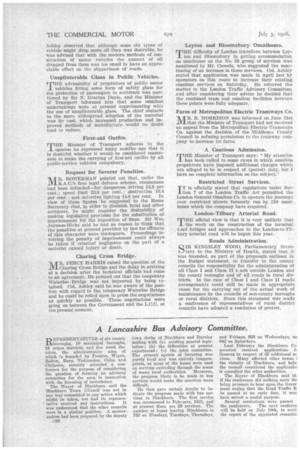ROAD TRANSPORT MATTERS IN PARLIAMENT.
Page 47

Page 48

If you've noticed an error in this article please click here to report it so we can fix it.
The Police Report on London Motor Traffic. 'Traffic Census Shows Increase. Non-splintering Glass in Buses. The Minister and Additional Bus Charges to Cover the Petrol Duty.
Ey Our Special Parliamentary Correspondent. , .
. . .
THE report for 1927 of-the Commissioner of Police of the Metropolis has been issuedas, a Parliamentary paper. It states that raofor vehicles stolen in all parts of Great Britain during the year numbered 1,932, of a declared value of i97,307: The previous year the number was 1,468, which was more than double that of 1925 and nearly three times that of each of the three preceding years. In 1927 1,695 vehicles were recovered. Reference is made to the round-about system in London, which, I,: is stated, has not led to greatly increased speed of movement and consequently greater danger. The system has continued to work satisfactorily, the object . being to reduce to a minimum the actual holding-up of traffic and to create, a continuous flow at a normal rate. It is noted that white lines continue to be of great asststance in the direction and control of traffic, and have been the means of preventing many accidents. Finality has not been reached as to the best material for use as white lines and experiments are still proceeding. Many improvements have been made in the provision of refuges. The results of the trial of marking by aluminium strips the stopping-places for omnibuses is under consideration. The difficulty of providing adequate parking places in the central part of London and the manipulation of traffic on special occasions are commented upon.
London Traffic Census.
TilE annual census of traffic passing 98 selected points in London within 12 hours on one day resulted In the following figures:—
Light motorcars, including cabs ... 43.19 Cycles, including motorcycles ... . . 18.21 Motor omnibuses ... ... 15.25 Heavy motorcars (excluding omnibuses) 8.91 Light horse-drawn vehicles ... ... 3.95 Heavy horse-drawn vehicles ... 4,33 Electric tramcars ... ... 4,39 Barrows, etc. ... .. ... ... 1.77 ' There was an increase in volume over that of the 1926 census of approximately 2.43 per cent. The increase is almost wholly in the light motorcar class, the only other class to show an increase being heavy motorcars.
Public Vehicles.
I)IJRING the year 16,963 public carriages were licensed, viz., 8,147 cabs (including 150 horsedrawn), 5,837 omnibuses (including three horsedrawn brakes), 2,750 tramcars, and 229 chars-abanes. There was an increase eompared with 1926 of 414 motor omnibuses and 60 tramcars, and a decrease of 295 motorcabs, 36 horse cabs and 3 chars-a-banes. Some of the omnibuses, it is pointed out, were licensed more than once during the year. No new type of motorcab has been licensed for service. Two new types of motor omnibus have been licensed, viz., L.G.O.C. "Len'don 6" six-wheeler and " Guy " six-wheeler, both having covered tops. In view of the ever-growing volume of traffic and increasing difficulty of circulation, the tendency to increase the size of such vehicles needs to be carefUlly, watched and the effect on traffic in general fully considered before final approval can be given. No further steps have
been taken by the two-seater cab firms towards the licensing of .this type of vehicle. During the year 394 new motoremnnibuses and 205 new motorcabs were licensed, and at the end of the year 1,623 covered-top omnibuses had been licensed and 110 approved routes or short sections authorized for operation by this type of onanibits.
Causes of Accidents in London'.
FATAL accidents numbered :-707 pedestrians, 96 occupants of vehicles, 249 cyclists and 4 unclassified; total, 1,056. This compares with 1,003 in 1926 and 840 in 1925. An analysis Of the causes shows the following result :— (1) Pedestrians crossing the roadway—
Without due care 281 Hesitating and/or faltering ... 110 Passing between vehicles or behind or in front of stationary vehicles 82
(2) Pedal-cyclists
Skidding ... 41 Collisions ... 89 (3) Motorcyclists—.
Skidding 13 Collisions „. 87
(4) Playing—
In roadway... 23 On footway or verge and suddenly step-.
ping into roadway 16
(5) Pedestrians improperly riding on , vehicles—
Behind or in vehicle .. 10 On connecting bar ... ... 6
Miscellaneous Features of the Report.
TRIALS of four-wheel-brake systems were in °peel_ ration on the Dennis, Guy, Leyland, Maudslay, Lancia and Associated Daimler vehicles. None had been submitted for motor cabs, but the early submission of one was anticipated. The road tests for =tombs which commenced in 1923 have been continued, with the result that 15 vehicles have failed to pass the first trial; 49,962 drivers' and conductors' licences were issued, being an increase on the year 1926 of 422 and constituting a record for the department. This total is made up of 10,629 cab drivers, 13,138 stage drivers, 17,857 conductors and 2,338 composite (driver and conductor combined) ; 51,371 applications for drivers' and conductors' licences were received; 305 applicants for cab drivers' licences passed the examination in knowledge of London and its environs. Many had to be re-examined several times, with the result that no fewer than 7,503 separate examinations were needed ; 6,405 examinations in the driving of motorcabs and omnibuses were held ; 5,041 men passed the test. A proportion of these, however, passed after. one or more failures.
Oil on Roads.
ASUGGESTION was made by Sir Robert Thomas that, in view of the increased slipperiness of the roads due to oil and grease dropping from motor vehicles, inquiries should be instituted Into the best type of undertray to catch such leak
ages, with a view to standardizing it. Colonel Ashley observed that although some old types of vehicle might drop more oil than was desirable, he was advised that with the modern methods of construction of motor vehicles the amount of oil dropped from them was too small to have an appreciable effect on the slipperiness of roads.
Unsplinterable Glass in Public Vehicles.
rrim advisability of proprietors of public motor .1 vehicles fitting some form of safety glass for the protection of passengers in accidents was mentioned by Sir N. Grattan Doyle, and the Minister of Transport informed him that some omnibus undertakings were at present experimenting with the use of unsplinterable glass. The chief obstacle to the more widespread adoption of the material was its cost, which increased production and improved methods of manufacture would no doubt tend to reduce.
First-aid Outfits.
THE Minister of Transport adheres to the opinion he expressed many months ago that it is doubtful whether it would-be considered reasonable. to make the carrying of first-aid outfits by all public-Service vehicles compulsory.
. Request for Severer Penalties.
MR. BOWERMAN pointed out that, under the R.A.C.'s free legal defence scheme, summonses had been defended—for dangerous driving 24.3 per cent.; speed limit 23.8 per cent.; obstruction 10.4 per cent.; and defective lighting 14.0 per cent. In view of these figures he suggested to the Home Secretary that, in order to diminish fatal and other accidents, he might consider the desirability of making legislative provision for the substitution of imprisonment for the imposition of fines. Sir Win. Joynson-Hicks said he had no reason to think that the penalties at present provided by law for offences of this character were inadequate. Proceedings involving the penalty of imprisonment could always be taken if criminal negligence on the part of a motorist caused injury or death.
Charing Cross Bridge.
R. PERCY HARRIS raised the question of the Chariag Cross Bridge and the delay in arriving at a decision after the technical officials had come to an agreement. He pointed out that the temporary Waterloo Bridge was not improved by being etained. Col. Ashley said he was aware of the position with regard to the temporary Waterloo Bridge and he could be relied upon to press the negotiations as quickly as possible. These negotiations were going on between the Government and the L.C.C. at the present moment. Leyton and Bloomsbury Omnibuses.
THE difficulty of London travellers between Leyton and Bloomsbury in getting accommodation on omnibuses on the No. 38 group of services was mentioned by Mr. Cassels, who suggested the sanctioning of an increase in those services. Col. Ashley stated that application was made in April last by operators on this route to increase their existing omnibus services on Saturday. He referred the matter to the London Traffic Advisory Committee, and after considering their advice he decided that the combined tram and omnibus facilities between these points were fully adequate.
Fares of Metropolitan Electric Tramways Co, R. R. MORRISON was informed on June 21st it/R. the Minister of Transport had not received an appeal from the Metropolitan Electric Tramways Co. against the decision of the Middlesex County Council in refusing permission to the tramway company to increase its fares.
A Cautious Admission.
THE Minister of Transport says : "My attention has been called to some cases in which omnibus proprietors have imposed additional charges which are alleged to be in respect of (petrol) duty, but I have no complete information on the subject."
Restricted Street Services.
IT is officially stated that regulations under Section 7 of the London Traffic Act permitted the London General Omnibus Co. to operate the journeys over restricted streets formerly run by 210 omni-, buses which the company have acquired.
London-Tilbury Arterial Road.
THE official view is that it is very unlikely that the work on the construction of the terminal road bridges and approaches to the London-to-Tilbury arterial road will be begun this year.
Roads Administration.
SIR KINGSLEY WOOD, Parliamentary Secretary to the Ministry of Health, stated that it was intended, as part of the proposals outlined in the Budget statement, to transfer to the county councils the responsibility for the administration of all Class I and Class II r_ads outside London and the county boroughs and of all roads in rural districts. In the case of Class I and Class II roads arrangements could still be made in appropriate cases for the carrying out of the actual work of maintenaneeby the councils of non-county boroughs or rural districts. Since this statement was made a conference of representatives of rural district councils have adopted a resolution of protest.












































































































